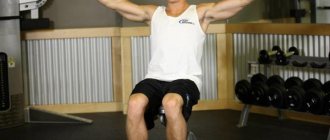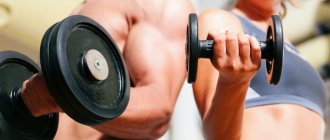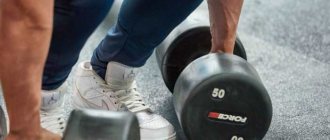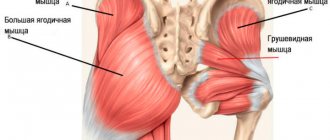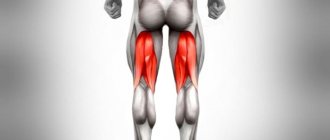Content
- 1 Shoulder training in the gym
- 2 Introduction to the shoulder muscles
- 3 The pleasure of strong shoulders
- 4 Great Shoulder Workout
- 5 How to avoid mistakes when training shoulders in the gym 5.1 Excessive movement
- 5.2 Arching the back
- 5.3 Rocking back and forth
- 5.4 Performing exercises from behind the head
- 6.1 Dumbbell shoulder press
Shoulder training in the gym[edit | edit code]
Main article:
Shoulders - exercises and training features Anterior shoulder muscle group
When you move your hands in almost any direction - up, down, back, forward, sideways, etc. - your shoulders are responsible for all this (or at least participate in it). The ingenious design of the shoulder joints makes the shoulders one of the most mobile and versatile parts of your body.
Unfortunately, their amazing mobility also makes the deltoid and adjacent muscles called rotator cuffs particularly vulnerable to injury. How to be? Read this article carefully for all kinds of gym exercises that will help strengthen your shoulders and prevent them from getting damaged. And if disco dancing ever comes back into fashion, you'll be ready for it.
How to pump up your shoulders in the gym - video from our team
If your shoulder workout seems boring to you and you would like to add some variety to it, then we invite you to try training with the Fit Magazine team! We have prepared a fitness video especially for you about the best shoulder exercises in the gym together with Yuri Sakharov and Sergei Soklakov:
Follow the link to find another cool video of our workout and a lot of useful information on how to pump up your shoulders.
We hope that our exercises for working out shoulders in the gym were very useful to you, and below you will see a description of our workout.
Description of our training and nuances
Our shoulder training program:
- Swings with dumbbells to the sides (we “pump” the deltas with blood as much as possible);
- Crossover pull-down (we include antagonist muscles to give maximum blood flow to the upper body, since they themselves are a very small muscle group);
- Heavy dumbbell swings (maximum weight);
- Smith machine incline press with a medium grip (uses all parts of the deltoid, but focuses on a shocking, powerful movement for a high number of repetitions and engagement of the front deltoid);
- Swings with dumbbells in a tilted position on the rear delta;
- Pulling the barbell back while bending over the rear deltoid (allows you to maximally strain and stretch the rear deltoid for greater blood flow);
- Swings with dumbbells in a tilted position on the rear delta (maximum pump);
- Bench press with a straight grip (performing a bench press increases the intensity of the workout and blood flow to the anterior deltoid area);
- Swing with dumbbells in front of you to the front deltoid;
- Swing in a crossover in front of you.
We hope our workout gave you an understanding of how to pump up your shoulders in the gym with the correct technique.
Thoughtful shoulder training + sports nutrition = maximum results
What do you think is needed to achieve a decent result and high-quality form? Most of you will answer - “cool, thoughtful workouts.” And, damn it, you will be right!.. But only half) An equally important component of progress is full recovery. Let's not forget that according to the classics of the genre, our muscles receive microtrauma during training and grow precisely DURING RECOVERY!
So what does it take to recover and grow? “A competent nutrition plan,” you say, and again you will be only half right! The reality is that an athlete cannot get all the necessary elements for recovery from regular food, and various factors can prevent this:
- Poorly thought out diet (amount of kcal, dietary supplements, vitamins, minerals, etc.;
- Insufficient function of the gastrointestinal tract, which does not allow the absorption of all useful substances completely;
- Poor quality of food (which is not uncommon in modern realities), etc.
Thus, you can supplement and improve your diet only with the help of sports supplements, and the following should be mandatory on your list:
- Multivitamins (allow you to support the immune system and, in principle, the balanced functioning of the body systems);
- Amino acids (are a quick restorative material for muscles);
- Protein (allows you to supplement the lack of protein from food + is a truly high-quality source of protein);
- Creatine (makes it possible to increase the energy reserves of muscle cells to give impetus to weight progression and greater returns from training);
- Pre-workout complex (gives additional motivation and improves the quality of training, which directly affects your results).
Today, not a single athlete who is determined to achieve serious results can do without a basic set of sports nutrition. And those who say that they can achieve everything without him are just perpetrating a whim! Be smart and approach achieving your goals wisely!
If you still doubt whether sports nutrition works, we recommend this video:
It is important to consider that not every beginner can choose sports nutrition on their own. In this matter, you need a competent consultant!
Getting to know the shoulder muscles[edit | edit code]
Main articles:
Muscles of the shoulder girdle and Muscles of the arms Posterior group of shoulder muscles
Officially, the shoulder muscles are called deltoides.
, or
deltoid
. They are like two caps covering both of your shoulder joints from above (the best way to see them is to stretch your arm horizontally). If we talk about the structure, then the deltoid consists of three parts.
- Central.
The upper, or middle, deltoid muscle is located at the top of the shoulder. When it contracts, you are able to raise your arm.
- Front.
This deltoid muscle is located in front of the shoulder. When it contracts, the hand moves inward, towards the center of the chest.
- Rear.
When this deltoid muscle, located behind the shoulder, contracts, the arm returns to its normal position and may even move back a little.
Your shoulders are able to move in different directions due to the presence of ball-and-socket joints
. The round head of the humerus sits tightly in the joint capsule, free to rotate as you need. There is another pair of these ball-and-socket joints between your pelvis and hips, but it doesn't have the mobility of your shoulders.
Shoulder Rotators
is a group of four muscles that prevent the shoulder bones from slipping out of the socket. They pass below the deltoids, quietly doing their job. Unfortunately, shoulder rotators are so subtle that many people don't even know they exist and therefore don't bother training them. Typically, we only find out about them when a professional baseball player is sidelined for an entire season due to their injury. The rotator cuff muscles stabilize the shoulder joint and allow you to rotate your arm without bending your elbow, such as when you rotate your palm forward and then back. They also come into play when throwing and raising your arms above your head.
Shoulder anatomy
The shoulders consist of three beams: Anterior delta Middle delta Rear delta
- The anterior delta is responsible for abducting the shoulder forward
- Middle delta for shoulder abduction
- Rear delta for abducting the shoulder back in the horizontal plane.
Also, the shoulder joint is anatomically the most complex in structure and is responsible for pressing and traction movements.
The pleasure of strong shoulders[edit | edit code]
Of course, your shoulders do quite a lot of work whenever you do chest and back exercises in the gym. However, exercises that focus solely on training the deltoid muscles are also important. There are several good reasons for doing them.
- Real life benefits.
Strong shoulders make most arm movements easier. Whether you and your brother are playing in the snow, throwing potatoes over the table, or lifting your “slightly heavy” suitcase, they are the ones doing the work. Your shoulder muscles are worked to some degree in almost every upper body exercise. This means that strengthening them will allow you to lift more weight when training your back and chest in the gym.
- Preventing injuries.
Weak shoulder muscles often suffer from various injuries, even if you perform all the exercises correctly. In addition, shoulder development exercises help prevent injuries that occur during unusual activities. After all, many people are busy with quiet sedentary work five days a week, and on weekends they suddenly start swinging a hammer, playing badminton, hockey, or digging beds. And in general, when you have weak shoulder muscles, injuries can await you even when you open a dresser drawer.
- Feel good factor.
Bodybuilders take shoulder training very seriously in the gym as they play a very important role in an athlete's appearance. But external attractiveness is the main goal of bodybuilding. But even if you're not looking to develop your deltoids for competition, you can still get them sculpted and bulging so you can proudly wear T-shirts and sleeveless tanks. (Of course, you can wear them whenever you want. However, sculpted shoulder muscles will give you confidence.)
Great shoulder workout[edit | edit code]
You can strengthen your shoulder muscles in the gym using four main types of movements (although there are dozens of training options). We recommend performing the exercises below in the order they are listed. Generally speaking, the heaviest load is used when pressing dumbbells or barbells, and the lightest is used when raising your arms while bending over.
- Bench press
This exercise involves straightening your arms above your head and is aimed at developing all deltoid muscles.
- Raising your arms to the sides.
Here you need to raise your arms through your sides up to shoulder level. This exercise develops the upper and outer shoulder muscles.
- Raise your arms forward.
In this case, the arms are raised from the sides straight in front of you. This exercise develops the front and upper deltoid muscles.
- Raising your arms while bending over.
This exercise involves bending your pelvis as far as your flexibility allows you to resist gravity. The chest should be parallel to the floor. By doing this, you develop the back and outer deltoid muscles.
The order of exercises can be changed from time to time to place the bulk of the load on weaker muscles and provide a variety of stimuli. Of course, there is no need to include all four types of exercises in every shoulder development routine. But you should try to practice them regularly to achieve even development of the shoulder muscles.
Try to train your shoulders more with free weights rather than on machines. Very often, when exercising on a power machine, the movements turn out to be unnatural, which leads to excessive stress on the neck. In addition, for weak people, for example, graceful women, it is quite difficult to adapt a machine designed for a powerful bodybuilder.
Remember that rotator cuffs are highly susceptible to injury. These muscles can be protected to some extent by doing the following:
- Maintaining correct technique.
Carefully follow the instructions that come with the upper body exercises.
- Perform exercises to rotate your arms in and out.
This article includes two such exercises that can be performed with dumbbells.
- Using exercises with an expander.
Such exercises for developing shoulder rotators that can be done at home or somewhere on the road.
How to properly organize delta training in terms of anatomical features?
Even though the shoulders seem like a very small muscle group, they are capable of generating enormous force. But, unlike, for example, the lower leg, the shoulders can make more movement in the joints when performing exercises. By using various muscle fibers, the joint can rotate the arm inward and outward, abduct and adduct, lift in front of you, etc.
From an anatomical point of view, the structure looks like this: the outer part of the clavicle connects to the upper edge of the scapula and the round head of the humerus, forming a hinge-type joint. Due to the fact that the glenoid fossa is shallow, we can rotate the arm in any direction (which is impossible to do with some other joints in our body). The muscle that attaches to the joint is the deltoid, which divides into three heads: anterior, middle and posterior.
Shoulder training is most often compiled on the basis of which of the heads responds better to the load, which is better developed genetically, and which is lagging behind. It is very important to arrange the load so that the deltoids develop evenly, creating an aesthetic, rounded shoulder shape with a peak in the middle. To better understand how to quickly pump up your shoulders by using all deltoids, you need to understand the functions of each of them:
- The anterior delta flexes the shoulder, turns the arm inward and lifts it up;
- The middle bundle abducts the arm;
- The rear delta extends the shoulder, turns outward, and lowers the arm down.
If you look at any TOP of the best shoulder exercises, you will see that such training uses both basic and isolating types of load.
Compound exercises for developing shoulder strength are used most often, simply because they allow you to handle heavier weights and engage ALL heads of the deltoid. Such exercises include:
- Standing press or military press;
- Seated dumbbell press or similar machine presses;
- Press in Smith;
- Barbell row to the chin or broach;
- Arnold press.
Isolating shoulder exercises usually complement the basic ones and are used to develop lagging deltoid heads (most often the posterior or middle). Isolation is called that because it allows one of the deltas to be loaded to the maximum and the rest “switched off” from operation. Isolation exercises for the posterior bundle include:
- Swing dumbbells to the sides in an inclined position;
- Dumbbell swings lying on your stomach;
- Reverse flyes in the simulator.
Isolation of the anterior delta is presented:
- Raising the lower block in front of you;
- Lifting dumbbells or barbells in front of you.
Middle beam isolation:
- Swing dumbbells to the sides while standing or sitting.
Let us repeat once again that it is necessary to build your training program based on your anatomical features, the lag and predominance in the development of the anterior, middle and posterior deltas. Beginners are recommended to start by developing strength in BASIC exercises and adding small isolation exercises.
How to avoid mistakes when training shoulders in the gym[edit | edit code]
Even among active weightlifters, shoulder injuries do not go away overnight. We know countless people who have been pumping iron for years, often ignoring minor shoulder pain, and then - boom! - that's all. Their shoulders simply refused to work properly. However, what they perceived as an injury that came out of nowhere was in fact the natural result of prolonged overtraining and incorrect work technique. Avoiding injury while keeping your shoulders strong and healthy isn't all that difficult—you just need to avoid making the common mistakes we'll cover below.
Excessive movement[edit | edit code]
If the instructions say to “raise the dumbbells to shoulder height,” do not lift them toward the ceiling, as moving at an unnatural angle will place unnecessary stress on the joint. There is practically no benefit from this for improving muscle tone. In other words, the risk of injury from lifting more than required far outweighs the tiny chance of getting stronger from it.
Arching the back[edit | edit code]
When performing shoulder exercises on a bench with a vertical back, make sure that there is only a small gap between your lower back and the seat. Of course, arching your back allows you to lift a heavier load, but it doesn't really strengthen the muscles you're interested in and leaves your lower back more vulnerable, leading to injury.
Rocking back and forth[edit | edit code]
When performing exercises for the shoulder girdle while standing, you need to relax your knees and try to keep your body straight, maintaining correct posture. Unfortunately, many people overextend their knees and lean backward into a position that their lower back doesn't necessarily welcome. But remember: moving any part of your body other than your arms does not properly develop your shoulders. If you simply cannot lift the selected weight otherwise, you just need to reduce it.
Performing exercises from behind the head[edit | edit code]
You've probably seen athletes who press dumbbells overhead, lowering them behind their heads rather than forward. Some shoulder training machines also involve overhead movements. Here's our advice: stay away from such exercises! They require a deep rotation of the arms back, placing the deltoids and rotator cuffs in a weaker and more dangerous position. In addition, such movements pinch the heads of the humerus bones in the joints, which leads to their damage and creates additional stress on the rotators. And in general, you should always remember that the benefits of any exercise must outweigh the risks.
Practice shoulder exercises[edit | edit code]
Here is a list of gym exercises that we will look at later in this article.
- Dumbbell shoulder press.
- Raising your arms to the sides.
- Raise your arms forward.
- Raising your arms while bending over.
- Rotate your arms in and out.
- Shoulder press on the machine.
Dumbbell shoulder press[edit | edit code]
Main article:
Standing dumbbell press Fig. 2. Dumbbell shoulder press. Don't lock your elbows at the top of the movement
This exercise is aimed at developing the upper and central part of the shoulder muscles in the gym. In addition, it strengthens the upper back and triceps.
Be careful if you have lower back, neck or elbow problems.
Preparing for the approach
Hold a dumbbell in each hand and sit on a bench with a backrest. Place your feet firmly on the floor, approximately hip-width apart. Bend your elbows and raise them to shoulder height so that the dumbbells are approximately at ear level. Pull your stomach in and tighten your abdominal muscles so that there is only a small gap between your lower back and the back of the bench. Rest the back of your head on the bench cushion (photo A in Fig. 2).
Exercise
Press the dumbbells up and inward until their ends almost touch directly above your head, then lower them back to ear level (Photo B in Figure 2).
What to do and what not to do
- Keep your elbows bent and relaxed until the very end of the movement; do not lock them by straightening your arms completely.
- Stop lowering the dumbbells when your elbows are at or just below your shoulders.
- Don't arch your back too much, forming a large arch over the back of the bench.
- Don't fidget or jerk from side to side in an attempt to lift more weight.
Other options
- Dumbbell press with palms facing in
(easier). Try this exercise with your palms facing each other. This will allow you to engage your wrists and biceps.
Raising arms through the sides[edit | edit code]
Main article:
Raising arms with dumbbells in front of you Fig. 3. Raising arms through the sides. Do not lift the load above shoulder level
This exercise helps develop the central part of the pleural muscles. Pay attention to your technique, especially if you have neck or lower back problems.
Preparing for the approach
Hold a dumbbell in each hand and stand straight with your feet hip-width apart. Bend your elbows slightly, face your palms toward each other, and bring the dumbbells together in front of your thighs. Pull your stomach in and tighten your abdominal muscles (photo A in Fig. 3).
Exercise
Raise your arms up and out until the dumbbells are just below shoulder level. Slowly lower the dumbbells back down. (Imagine that you are pouring two jugs of lemonade on the floor in front of you or watering flowers from two watering cans at once - photo B in Fig. 3).
What to do and what not to do
- When performing the exercise, work exclusively with your shoulders. In other words, keep your elbows in the same position at all times - slightly bent.
- Don't arch your back, lean back, or rock back and forth as you try to lift more weight.
- Do not lift the dumbbells above shoulder level.
Other options
- Raising bent arms
(easier). Begin the set with your elbows bent at a 90° angle, your palms facing each other, and holding the dumbbells in front of you. Next, keeping your arms bent throughout the exercise, lift the dumbbells so that your elbows reach shoulder level.
Of course, the bent arm raise does not develop the shoulder muscles as well as the basic version. If your shoulders are weak or sore, it is better to use this particular exercise option.
- Raising arms while sitting
. For a change of pace, try doing lateral raises while sitting on a bench. In this case, at the beginning of the movement, the arms should hang straight down at the sides of the body, slightly bent at the elbows. - Raising your hands with your thumbs up
(easier). Perform this exercise with your palms facing forward and your thumbs pointing upward. This version places less stress on the shoulder rotators and is often used in physical therapy.
Raising your arms forward[edit | edit code]
Main article:
Raising arms with dumbbells forward Fig. 4. Raise your arms forward. Do not raise your arms above shoulder level
This exercise works exclusively the front part of the shoulder muscles. When performing it, be especially careful if you suffer from long-standing lower back or neck pain.
Preparing for the approach
Hold a dumbbell in each hand and stand straight with your feet hip-width apart. Allow your arms to hang freely at the sides of your body, keeping your elbows slightly bent and your palms facing back. Pull your stomach in and relax your knees (Photo A in Fig. 4).
Exercise
Raise your right arm up to shoulder height, then lower it back down. Do the same with your left hand. Continue changing hands until you complete the set. Or, to increase the load, complete all planned repetitions first with one arm and then with the other (photo B in Fig. 4).
What to do and what not to do
- Keep your elbows slightly bent until the end of the exercise.
- Don't arch your back, lean back, or sway from side to side as you try to lift the dumbbell.
- Do not raise your arms above shoulder level.
Other options
- Raise your arms forward with your palms up
. Turn your palms up and perform the exercise exactly as described in the basic version. You will especially benefit from trying this option if you are prone to deltoid or rotator cuff injuries. - Diagonal lift of arms forward
(heavier). Raising your arm to shoulder height, move it inward a couple of centimeters until the dumbbell is in front of your upper chest. If you have chronic shoulder problems, it is better to avoid this version. - Raising your arms forward while sitting
(heavier). Perform the basic version of the exercise while sitting on a bench with a backrest; this will help eliminate any possibility of incorrect execution. - Raise your arms forward while lying down
(heavier). Lie on a bench on your stomach, holding a dumbbell in each hand and straightening your arms directly under you (or slightly spreading them out to the sides). Turn your palms inward, thumbs up. Next, lift the dumbbells as high as you feel comfortable, but not above shoulder level. For this version of the exercise you will have to use a much lighter weight. You can also use a rising bench and do the same on it.
Raising arms while bending[edit | edit code]
Main article:
Arm raise Fig. 5. Raising arms while bending over. When performing the exercise, move only your arms and shoulders
This exercise is great for strengthening the back of your shoulders and upper back. In addition, it improves posture.
Preparing for the approach
Hold a dumbbell in each hand and sit on the edge of a weight bench. Bend deeply forward at the pelvis so that your upper back is straight and almost parallel to the floor (if you can, rest your chest on your knees). Allow your arms to hang down freely with your palms facing each other and the dumbbells resting behind your calves just below your knees. Slightly lower your chin to your chest and draw in your stomach (photo A in Fig. 5).
Exercise
Raise your arms out to your sides, bending your elbows slightly. At the end of the movement, your elbows should be at shoulder level. As you move, squeeze your shoulder blades together. Then slowly and smoothly lower your arms back, returning to the starting position (photo B in Fig. 5).
What to do and what not to do
- Keep your chin tucked slightly toward your chest throughout the exercise to prevent your head and neck from lifting up.
- Bend forward at the hips instead of arching your back. S Don't let the rest of your body move while you do the exercise.
Other options
- Reverse thrust on the deltoids
. Use the same starting position, except with your palms facing back. When lifting dumbbells in this version of the exercise, you will have to bend your elbows more than in the basic version. - Extension of arms while bending over on a cable machine
. This version is especially useful if you have been experiencing neck pain for a long time. Place the cable block as close to the floor as possible and attach a special horseshoe-shaped handle to it. Kneel with your side to the counter and grab the handle with the hand that is farthest from the machine. (The cable will need to pass under your body.) Squeeze your shoulder blades together and lift your hand with the handle up through your side, as you did in the basic version. Be sure to perform the same number of repetitions with each arm. - Standing reverse deltoid row
. Try doing the same exercise standing with your feet hip-width apart. Lean your body forward at an angle of 45°. Keep your stomach tucked in to protect your lower back from injury, and avoid any side-to-side rocking.
External rotation of arms[edit | edit code]
Rice.
6. Rotate your arms outward. External rotation of arms. Think of your arm as a trap door that moves up and down. This exercise primarily targets the rotator cuff, but also strengthens the deltoid muscles.
If these movements cause discomfort in your neck, try placing a freely extended arm under your head.
Preparing for the approach
Holding a dumbbell in your right hand, lie on the floor on your left side. Bend your right elbow to a 90° angle and place it firmly at your side with your palm facing down. Pull your stomach in. Support your head with your left arm, bent at the elbow, or lie on your outstretched left arm.
Exercise
Without lifting your elbow from your side, rotate your right arm, raising it as high as you feel comfortable (the height here will depend on your flexibility). Then slowly lower the dumbbell back to the floor. Perform the same number of repetitions with each arm. This exercise is shown in more detail in Fig. 6.
What to do and what not to do
- Imagine that your shoulder is the hinge of a hatch door that opens and closes.
- Perform the exercise carefully and smoothly.
- Don't crane your neck or raise your face.
- Do not lower the dumbbell too sharply or throw it up.
- Don't try to lift the dumbbell higher than your natural flexibility allows.
Other options
- External rotation of the arms with an expander.
For a version of this exercise performed with a resistance band, see the article Exercises with a rubber band.
“Traffic Controller” (heavier). Hold a dumbbell in each hand and stand straight with your feet hip-width apart. Bend your elbows and raise them to shoulder level (in the classic “arms up!” pose). Keeping your elbows level, rotate your forearms down until your palms point back, then return them back to the starting position.
Inward rotation of the arms[edit | edit code]
Rice.
7. Rotate your arms inward. Rotate your arms inward. Perform this exercise smoothly, without throwing your arm straight up from the dumbbells. This exercise is also aimed mainly at strengthening the shoulder rotators, but also develops the deltoid muscles.
Again, if these movements cause you neck discomfort, try placing your free hand under your head.
Preparing for the approach
To rotate your arms inward, take a dumbbell in your left hand and lie on your back. Bend your elbow so that your forearm is perpendicular to the floor and your palm is facing inward.
Exercise
Lower your hand to the floor as far as your flexibility allows, and then lift it back up. Perform the same number of repetitions with each hand (Fig. 7).
What to do and what not to do
- Imagine that your shoulder is the hinge of a hatch door that opens and closes.
- Perform the exercise carefully and smoothly.
- Don't crane your neck or raise your face.
- Do not lower the dumbbell too sharply or throw it up.
- Don't try to lift the dumbbell higher than your natural flexibility allows.
Other options
Internal rotation of the arms with an expander.
A description of the version of this exercise performed with an expander can be found in the article Exercises with a rubber band.
- “Traffic Controller”
(heavier). Hold a dumbbell in each hand and stand straight with your feet hip-width apart. Bend your elbows and raise them to shoulder level (in the classic “arms up!” pose). Next, keeping your elbows level, rotate your forearms down until your palms point back, and then yank them back to the starting position.
Shoulder press on the machine[edit | edit code]
Rice.
8. Shoulder press on the machine. Don't arch your back or fidget in your seat trying to lift more weight. This exercise is designed to develop your entire shoulders, as it engages all the shoulder muscles. In addition, it strengthens the triceps and upper back muscles.
Be especially careful if you frequently have problems with your neck, elbows, or lower back.
Preparing for the approach
Adjust the seat height of the machine so that your shoulders are approximately level with the block. Grasp the handles protruding forward with your hands (palms should be turned towards one another). Tuck your stomach in and press your back into the seat cushion, but leave a small natural gap between the cushion and your lower back (Photo A in Figure 8).
Exercise
Squeeze the handles upward without straightening your arms completely or locking your elbows. Then lower your arms so that your elbows are just below shoulder level (photo B in Fig. 8).
What to do and what not to do
- Relax your shoulders and keep them well below your ears, especially when raising your arms up.
- Avoid arching your back or fidgeting in the machine seat to try to lift more weight.
- Do not push your hands upward more sharply than necessary; otherwise you risk overstraining your elbow joints.
Other options
Many deltoid training machines have levers that work independently of each other. That's right, the left and right sides of these power machines are not connected, so each hand can carry different weights and different loads. If your sports club has such machines, we recommend trying to work on them. You'll get the convenience and safety that machines offer, but you'll also be able to strengthen your shoulders evenly, just as you would with free weights.
Essence and basic principles
Exercises for deltas, which are performed in the gym, are distinguished by their variety, technique, as well as sports equipment used during approaches. Regardless of which training program was chosen to develop the muscle fibers of the shoulder girdle, it is necessary to follow the basic principles of pumping deltas and the essence of each exercise.
All of them are described in detail in the table below:
| Basic principles | The essence of the exercises performed |
| Using your own body weight | Girls who are at the initial stage of deltoid muscle development and are just learning basic exercises need to use their own body weight. To pump up the muscle fibers of the shoulder girdle, it is recommended to perform approaches on the horizontal bar and uneven bars. A training program using these sports equipment will strengthen the tendons and connective tissue of the shoulder joint and prepare the body for stronger loads in the form of dumbbells, barbells, and machines with large weights. Pumping up the deltoid muscles using your own body weight makes all the contours of the shoulder girdle more attractive and aesthetic. Over time, when the deltoids are more developed, exercises on the horizontal bar and uneven bars can be complicated by using weights. From 2 to 5 or more kg is added to your own weight in the form of barbells or dumbbells. |
| Performing exercises with working weights | In order to maintain the deltoid muscles in optimal shape, ensuring their stable development, working weights are used. This is a mass of sports equipment that allows you to perform the exercise technically correctly, do 8-10 repetitions for 3 approaches and prevent excessive fatigue of the body. Training with working weights is recommended for girls who do not want to build muscle mass in the shoulder girdle, but who want to keep their body in good physical shape. |
| Pumping deltas with minimal weights | The use of minimal weights is recommended for overweight athletes. In this case, the task is not to increase the physical strength of the shoulder girdle and not to increase the volume of deltas, but to make the body more attractive. When using minimal weights, the emphasis is on a large number of repetitions, due to this, the effect of drying the deltas and burning excess fat tissue is achieved. The shoulders become more graceful and aesthetically attractive. |
| Performing exercises with maximum weights | This is a set of physical exercises, during which dumbbells, barbells, weights and exercise machines are used. The emphasis is on the largest possible weights, which are lifted for 3-5 repetitions in 3 sets. The main goal of this type of training program is to increase the volume of the deltoid muscles, increase physical strength and power. Performing exercises with maximum weights should be carried out under the supervision of a trainer or partner, who can provide timely insurance, prevent injury, and also point out potential errors in the technique of performing the exercise. |
| Effective use of exercise equipment | Pumping up the deltoid muscles should not be based solely on using barbells, dumbbells, kettlebells, horizontal bars and parallel bars. It is necessary to actively use simulators. The best training effect is achieved by using a “butterfly” sports equipment, a V-shaped bar that is pulled to the chest, and a T-shaped block. All these exercise machines can be found in any gym that positions itself as a sports facility where you can train all muscle groups. |
| Localized load on a specific group of muscle fibers | The deltoid muscles consist of several groups. These are anterior, middle and posterior fibers. Together they form a single shoulder girdle, protect the joint from injuries, excessive loads, premature wear, and also take part in the functioning of the musculoskeletal system. To achieve the maximum effect from pumping the deltoid muscles, during one workout you need to perform exercises on only one area. For example, pump only the front delts. In the next workout, focus on the back of the shoulder girdle. This approach will allow you to create maximum physical activity and achieve the best results in the development of muscles of a particular group. |
| Complex training | In order to have a beautiful body with proportional development, you should create an individual training program that will involve all parts of the body. In this case, the principle of training compatibility is taken into account. For example, it is best to train the deltoids on the same day as the biceps and triceps, and the back muscles develop well if the chest is loaded at the same time. |
| Combination of cardiac loads | Athletes who lift heavy weights, want to increase the physical mass of the deltoid muscles, or work on the relief and aesthetic appeal of the shoulder girdle, should take care of cardiological training. These are targeted loads that provide training for the cardiovascular system. They consist in the fact that 1-2 times a week a girl needs to jog lightly over a distance of at least 1.5-2 km, ride a bike, swim or race walk. The purpose of cardiac exercise is to preserve the health of the heart muscle and great vessels, which experience enormous overload when lifting a barbell, dumbbells or weights. |
| Correct exercise technique | Not a single exercise for developing the deltoid muscles will bring a positive effect if technical emphasis is not observed during its implementation. Insufficient elbow extension, lifting the barbell too quickly, or jerking can lead to underutilization of the muscles and, in some cases, even cause injury. |
| Strength development | Developing the physical strength of the deltoid muscles is one of the basic principles of playing sports in the gym. It is necessary in order to further increase weight and ensure constant progress in the development of deltas. The principle of strength training is to use the largest possible weights, which are lifted 1-3 times in 3 approaches. |
| Mass gain | Increasing the volume and muscle mass of the deltas is only possible with parallel development of strength. The principle of performing the exercises is similar to the above principle. Heavy weights are used with minimal repetitions. The gym uses sports equipment such as dumbbells, weights and barbells. Exercise machines act as an auxiliary element in the overall training program. |
| Achieving a relief effect | Most girls who go to the gym begin to pump up their deltoids and want to get beautiful shoulders with clearly defined contours. To achieve this effect, small weights are used, but the maximum number of repetitions is used. For example, the exercise of lifting dumbbells up is performed with a weight of 3 kg. In this case, the number of repetitions is up to 20 times. The muscle fibers of the shoulder girdle dry out, stand out in the subcutaneous layer and become as prominent as possible. |
| Variety of sports equipment | In the process of pumping the deltoid muscles, all sports equipment that is in the gym and is intended for systematic training of the shoulder girdle should be used. This will allow you to regularly perform a variety of exercises that will have a positive effect on the development of muscle fibers. |
| Drink plenty of fluids | Building muscle mass, physical strength, endurance of ligaments and tendons, as well as creating a beautiful contour of the shoulder girdle is impossible without receiving a sufficient amount of fluid. During training, you must drink at least 1 liter of clean drinking water. |
| Correct breathing | A prerequisite for maintaining a healthy heart system is proper breathing during exercise. A power jerk of a barbell, lifting dumbbells, kettlebells, or weights on a machine should always be accompanied by a deep breath, and the completion of the repetition by exhaling carbon dioxide. |
You can do delt exercises in the gym yourself, or use the services of a coach or instructor. At the same time, it is always necessary to remember that compliance with the above principles of the training process is mandatory. Otherwise, a positive result aimed at strengthening the deltoid muscles will not be achieved.
In addition, injury or the acquisition of diseases of the musculoskeletal system and cardiovascular system cannot be ruled out.




